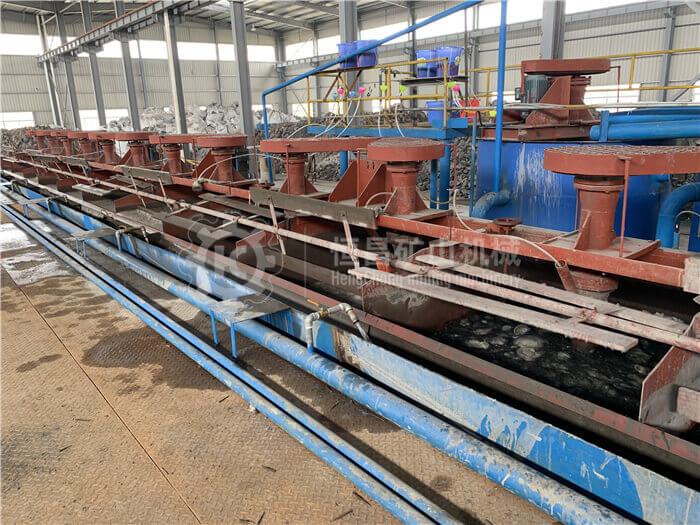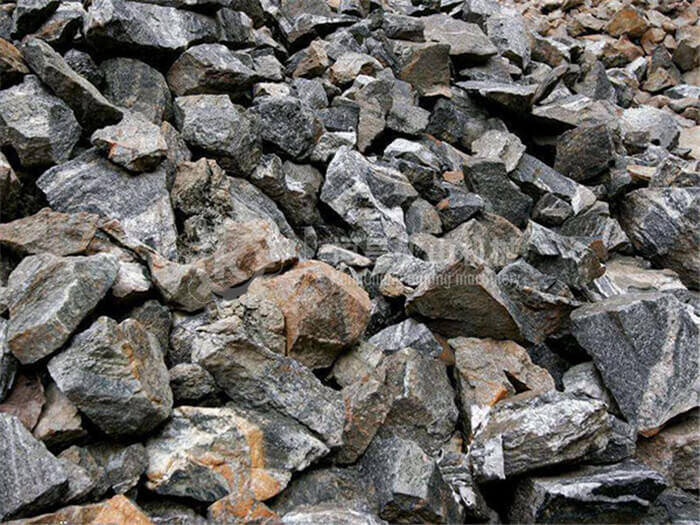Some beneficiation technology of oxide lead zinc ore
2020-03-21 15:34:41

Oxide lead-zinc ore always has a high oxidation rate and a fine dissemination. It coexists densely with oxidized minerals such as limonite. Most of them contain a large amount of native ore mud and easily muddy vermiculite, and sometimes contain soluble salts such as gypsum. In principle, there are the following methods for flotation of lead oxide zinc ore:
1. After the sulfide minerals have been floated, add a vulcanizing agent to sulfide the oxidized minerals, and then treat them according to the flotation method of lead and zinc sulfide ores.
2. When gangue is mainly silicate, gangue inhibitor is added to collect lead and zinc minerals with fatty acids.
3. Sodium sulfide is used as the activator of zinc oxide ore, and fatty amine is used to float zinc oxide minerals in alkaline medium.
For mixed ore, the principle process of “lead before zinc” or “sulfur before oxygen” can be adopted. That is flotation sequence as following:
Galena lead oxide mineral sphalerite zinc oxide mineral.
Galena-sphalerite lead oxide mineral zinc oxide mineral.
The white lead ore has good buoyancy. When the sphalerite has poor buoyancy, the previous process can be used to obtain better indicators. Otherwise, the latter process should be used. Using the latter process, the interference of HS and s remaining in the pulp after sulfidation of lead ore on the sphalerite can be avoided, which is conducive to sphalerite bleaching and reducing the amount of floating zinc collector. It is also possible to reduce lead concentrate. Zinc content in the mine.

Flotation method of lead oxide ore
Common lead oxide minerals are white lead ore, lead alum, arsenic lead ore, chromite lead chlorochlorite and molybdenum ore. Sodium sulfide, calcium sulfide, sodium sulfide, etc. are used for white lead ore, alum and molybdenum ore. However, lead alum requires a longer contact time for vulcanization, and the amount of vulcanization help J is relatively large. Arsenite, chromite, and chlorchlorite are difficult to sulphide, and their floatability is very poor. Most of them will be lost in the tailings during flotation. When flotation of lead oxide minerals, the commonly used vulcanizing agent is sodium sulfide. However, pay attention to the process conditions during vulcanization. Sodium sulfide should not be excessive, because excessive sodium sulfide will make the sulfide ion (HS) and sulfide ion (almost) concentrations in the pulp too high, which will inhibit the floatation of the cured lead oxide minerals; A large amount of sodium sulfide makes the pH of the pulp exceed ± 0.5, which is also harmful to flotation. In order to avoid the harm caused by excessive sodium sulfide, sodium sulfide can be added in sections or a small amount of copper sulfate or ferrous sulfate can be added after the sulfurization is completed to precipitate its harmful ions. During vulcanization, it is best to use low-speed non-aeration stirring to reduce the oxidation of sodium sulfide and avoid the peeling of the sulfur film on the surface of the ore particles. The pH value of flotation should be maintained at 8.5-10.
After the sulfurization of lead oxide minerals, the most effective collectors are long-chain xanthate, such as sec-octyl xanthate, which is more effective than butyl xanthate and pentoxanthin, and No. 25 is also effective.
Although fatty acid collectors such as oleic acid and oxidized paraffin soap can directly collect lead oxidized minerals, due to the poor selectivity of fatty acid collectors, it is fundamental for ores that are mainly carbonates or high in iron cyanide Out of service. Only high-grade ore with silicate as the main gangue can be used.
For mixed ore, the principle flow of lead sulfide floating out first, adding vulcanizing agent and xanthate flotation lead oxide is better. For example, when the effects of fine mud and soluble salts are serious, you can reduce the effect by removing mud or adding dispersants such as water glass.
Zinc oxide ore flotation method
The main zinc oxide minerals are magnesite (ZnCO3), red zincite (Zn0), and wurtzite (Zn2Si04). One of the most valuable is the siderite.
Zinc oxide ore flotation, currently industrially available methods include flotation with xanthate after heating and vulcanization, and flotation with cationic collector for sodium sulfide at room temperature.
1. Heating sulfuration flotation method. Firstly, remove the slime smaller than 0.001 mm, after concentrating, warm the pulp to 50-70 ℃, then sulfide the zinc oxide ore with sodium sulfide, and activate the sulfurized zinc oxide ore with copper sulfate. Chain xanthate is used as the main collector, diesel oil, tar, etc. are used as auxiliary collectors, terpineol oil is used as a foaming agent, water glass is used as a gangue inhibitor, and some methods of warming the flotation of zinc oxide ore can obtain relatively Good process indicators. However, in the production process, it often fluctuates due to improper control of various factors. If the raw ore contains a large amount of iron hydroxide, the effect is even worse.
2. Cationic collector method. This method is suitable for processing high iron-containing materials, and sodium sulfide is added before flotation. The effect of sodium sulfide here is different from its effect on lead oxide copper minerals. Excess sodium sulfide is not easy to inhibit. Therefore, the requirements for the adjustment of the amount of sodium sulfide and copper sulfate are not very strict.
When using a cationic collector, the effect of slime on the flotation effect is more prominent. However, when the content of fine mud less than 0.01 mm is less than 15%, adding soda, water glass, carboxymethyl cellulose, lignosulfonate, sodium humate, etc. can eliminate the effect, and it is not necessary to remove mud.
When the content of fine sludge less than 0.01 mm exceeds 15%, the consumption of the medicament increases sharply, so small desliming is not economically reasonable. In this case, it is necessary to remove part of the fine sludge in advance. At the same time, an appropriate amount of dispersant such as sodium sulfide and sodium silicate is added during the mud removal. Their important role in the desliming process is to disperse the fine mud, and it can also eliminate the effects of some harmful soluble salts.
Hengchang mining machinery can provide turnkey solution for mineral processing plant including research, design, manufacture, installation and commissioning, personnel training, after-sale service and management of processing plant. When you find us, you find a good mining machinery manufacturers.